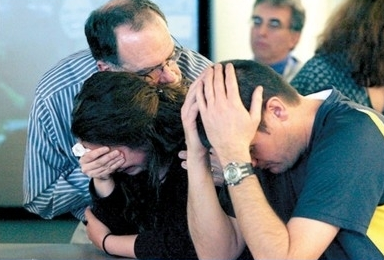(单词翻译:单击)
America is the land of breakthrough science -- and health care scams. The two seem to go hand in hand in the case of the new hepatitis C virus (HCV) cure named sofosbuvir, sold under the brand name Sovaldi by the drug company Gilead Sciences. There is no question that Solvadi is a godsend -- a lifesaver for millions of Americans, and perhaps someday for hundreds of millions of people around the world infected by Hepatitis C. Yet Sovaldi is also the poster child of a U.S. health care system that is being bankrupted by greed, lobbying and indefensible policies on drug pricing.
美国不仅仅拥有突破性技术发展,还有各种医疗保健骗局。在一款叫做Sofobuvir治疗丙肝病毒的药品中,我们看到了这两种事物似乎结合到了一起,Sofobuvir由药品公司Gilead冠以品牌名Sovaldi进行销售。毫无疑问,这款药是天赐之物,是数以百万计美国人的救命之物,或许某一天也会是全世界丙肝患者的救命之物。但是Sovaldi如今却成了美国医疗保险体系中的典型案例,美国的医疗保险体系正在被贪婪、游睡和本身却站不脚的药价政策所腐蚀。

The basic facts are these. In December 2013, the Food and Drug Administration approved Sovaldi, and another formulation, Harvoni, which is sofosbuvir used in combination with another drug. Gilead set the price for a 12-week treatment course of Sovaldi at $84,000, amounting to $1,000 per pill. Gilead set the price of Harvoni at $94,000.
基本事实是这样的,早在2013年,美国食品药品管理局批准通行了Sovaldi以及Harvoni,Harvoni其实是使用Sofobuvir和其他一些药物结合使用。Gilead将Sovaldi的12周药程定价为84000美元,大概相当于1000美元一片药,而Harvoni的价格则为94000美元。
According to researchers at Liverpool University, the actual production costs of Sovaldi for the 12-week course is in the range $68-$136. Indeed, generic sofosbuvir is currently being marketed in India at $300 per treatment course, after India refused to grant Gilead a patent for the Indian market. In other words, the U.S. price-cost markup is roughly 1,000-to-1!
根据利物浦大学的研究,Sovaldi的12周实际药程成本不过68到136美元。在印度拒绝给予Gilead专利权之后,印度市场上销售Sofobuvir的仿制品每疗程只有300美元。也就是说美国市场上利润和成本比几乎高达1000比1.
How can Gilead Science charge $84,000 for a drug that costs less than $300 to produce? First, Gilead's patent on sofosbuvir runs until 2028, giving it a monopoly in the U.S. market. Second, a range of Federal and state government programs will cover the $84,000 for a sizeable number of patients. For those not covered by government programs, some will be covered by private insurance, a few will pay out of pocket, and still others will likely die because they lack coverage and can't afford the treatment.
Gilead把不到300美元的药定价为84000美元,为何如此胆大妄为。第一,Gilead的在美国的特许经营权要到2028到期,第二,相当一部分病人所支付的84000美元费用会由联邦政府和州政府的医保项目支付,即使没有政府的医保项目,也有一部分人有私人保险,其余少部分人会倾家荡产,肯定还会有人既没有保险也没钱,会面临死亡。
In the first year of marketing, Sovaldi and Harvoni are already blockbusters, reaping a remarkable $12.4 billion of market sales in 2014, more in just one year than the $11.2 billion price that Gilead paid in January 2012 to buy sofosbuvir from a biotech start-up named Pharmasett.
在进入市场的第一年Sovaldi和Harvoni就已经名声大噪,在2014年狂掠124亿美元销售额,而2012年1月Gilead从一家叫做Pharmasett的创业生物科技公司买到Sofobuvir的价格也不过112亿美元。
The standard defense by the drug companies of these astronomical prices is that drug discovery is costly and their high profits reimburse the R&D costs. Here is where the story of Sovaldi gets even more interesting. The total private-sector outlays on R&D were perhaps $300 million, and almost surely under $500 million, meaning that the decade-long R&D outlays were likely recouped in a few weeks of drug sales.
药品公司对于要价过高通用的说法都是药品研发高,赚钱利润是为了偿还研发费用。这就是Sovaldi最让人注意的地方,私人部分对于Sovaldi的研发支出可能只有3亿美元,至多不超过5亿美元,就是说长达10年的研发费用,其实在药品出售几个星期后,就已经收回了成本。
Here is the background. Sofosbuvir was developed under the leadership of Prof. Raymond Schinazi, a brilliant professor of biochemistry at Emory University. The U.S. Government heavily funded Prof. Schinazi's research, with major grants from the National Institutes of Health (NIH) and support from the Veterans Administration. Like many academic researchers, Schinazi has frequently parlayed his government grants into private companies to market his discoveries. He set up Pharmasset Inc. as a Delaware corporation in 2004 as his business to develop sofosbuvir and hold the patents on the new prospective drug.
Sofobuvir由埃默里大学生化教授Raymond Schinazi领导开发,美国政府投入重金资助Schinazi的研究,还有美国国立卫生研究院和和退伍军人管理局的帮助。但是和很多研究者一样,Raymond Schinazi抛弃了美国政府而是转向私人企业以便于将其研究成果市场化,他在2004年特拉华建立了Pharmasett公司,专门研发Sofobuvir,并且取得了这一大有前景的药品的专利权。
Pharmasset raised around $45 million in a 2007 IPO and used those funds and others to supplement the R&D. According to the company's SEC filings, the total Pharmasset R&D on sofosbuvir up through 2011 totaled around $62.4 million. In January 2012, with an eye on sofosbuvir, Gilead paid $11.2 billion to purchase Pharmasett. Schinazi pocketed an estimated $440 million for his shares in Pharmasett.
Pharmasett在2007年首次公开募股4500万美元,用这笔钱进行研发,根据的公司的季度财报,Pharmasett在2011年研发Sofobuvir的投入总共约6200万美元,在2012年1月,虎视眈眈的Gilead出资112亿美元收购了Pharmasett,Schinazi在Pharmasett的股票约价值4.4亿美元。
By the fall of 2011, sofosbuvir was ready for Phase 2 clinical trials, which were carried out between October 2011 and April 2012 by the NIH, which published the results in the Journal of the American Medical Association in 2013. Phase 3 trials were then carried out in mid-2013 and were paid by Gilead, at a cost of perhaps $50-$100 million for a two-month trial that covered around one thousand patients. (Gilead has not disclosed the exact costs of the Phase 3 trials).
在2011年秋天,Sofobuvir准备进入第二阶段的临床试验,2011年10月到12年4月由美国国立卫生研究院执行,试验结果发布在2013年美国医学会的期刊上,第三阶段的临床试验在2013年中期进行,由Gilead出资,2个月的试验有大约1000名病人,花费大约在5千万美元到1亿美元。(Gilead没有公布第三阶段试验的支出)。
We can therefore estimate that private investors spent perhaps $300 million in R&D outlays for sofosbuvir over the course of a decade, and perhaps well below that sum. Those R&D outlays were likely recouped in a few weeks of sales in 2014.
我们可以估算私人投资者在Sofobuvir过去十年的研发花费了3亿美元,甚至可能会更低,这些研发在2014年药品开始销售后几个星期就已经收回。
With a rational drug pricing system, Gilead might have paid $1 billion rather than $11.2 billion for the drug, and Prof. Schinazi might have pocketed $40 million rather than $440 million. Sovaldi would most likely still have been developed and brought to market on the same timeline, but with taxpayers spared of perhaps $10 billion a year in outlays.
在药品价格合理的体系中,Gilead本应该是花费10亿美元而不是112亿美元得到Sofobuvir,而Schinazi教授应该得到4千万美元而不是4.4亿美元,纳税者也会每年省下100亿美元,Sovaldi也不会因为这些变动而不被开发或者推迟上市。
Gilead has worked the political system to protect its windfall by ramping up its lobbying activities. That soared to $2.2 million in 2013, the year of FDA approval, and $2.9 million in 2014, the first year of sales. The lobbying helped to smooth the way to the massive uptake of the drug and the substantial financing by the U.S. Government of Gilead's inflated prices.
Gilead为了保护这笔飞来之财,在政治体系上用心不小,增加其游说行动,2013年,也就是食品药品管理局批准通过的那一年,花费了220万美元。在2014年,上市的第一年,花费了290万美元,游说行为让大药剂量的服药不在受阻挠,让美国政府持续财政支持Gilead的天价药。
Sovaldi therefore represents the best and the worst of the U.S. health system. It represents the best of U.S. produced science, and the government's support for it. Sofosbuvir is a remarkable, life-saving medicine at the cutting edge of science.
Sovaldi成了美国医疗体系最好的和最坏的代表缩影,美国不有最好的科学,并且有政府的强力支持,Sofobuvir是尖端领域中非凡的救人良药。
Yet Sovaldi also shows how publicly financed science easily turns into arbitrarily large private profits paid for by taxpayers. The challenge facing the U.S. is to adopt a rational drug pricing system that continues to spur excellent scientific breakthroughs while keeping greed in check. Big Pharma and the U.S. public are on a collision course when they should be partners for the advancement of health.
Sovaldi上面,同样可以看到资助科学发展如何转变为医药公司专横的从纳税人身上掠夺财富,美国如今面临的挑战是要采取什么样的药品价格体系,不仅能刺激科学创新发展还能让监管其中的贪婪。大医药公司和美国公众本应该为医疗进步成为合作者,但是他们却站在了独木桥的两端。


